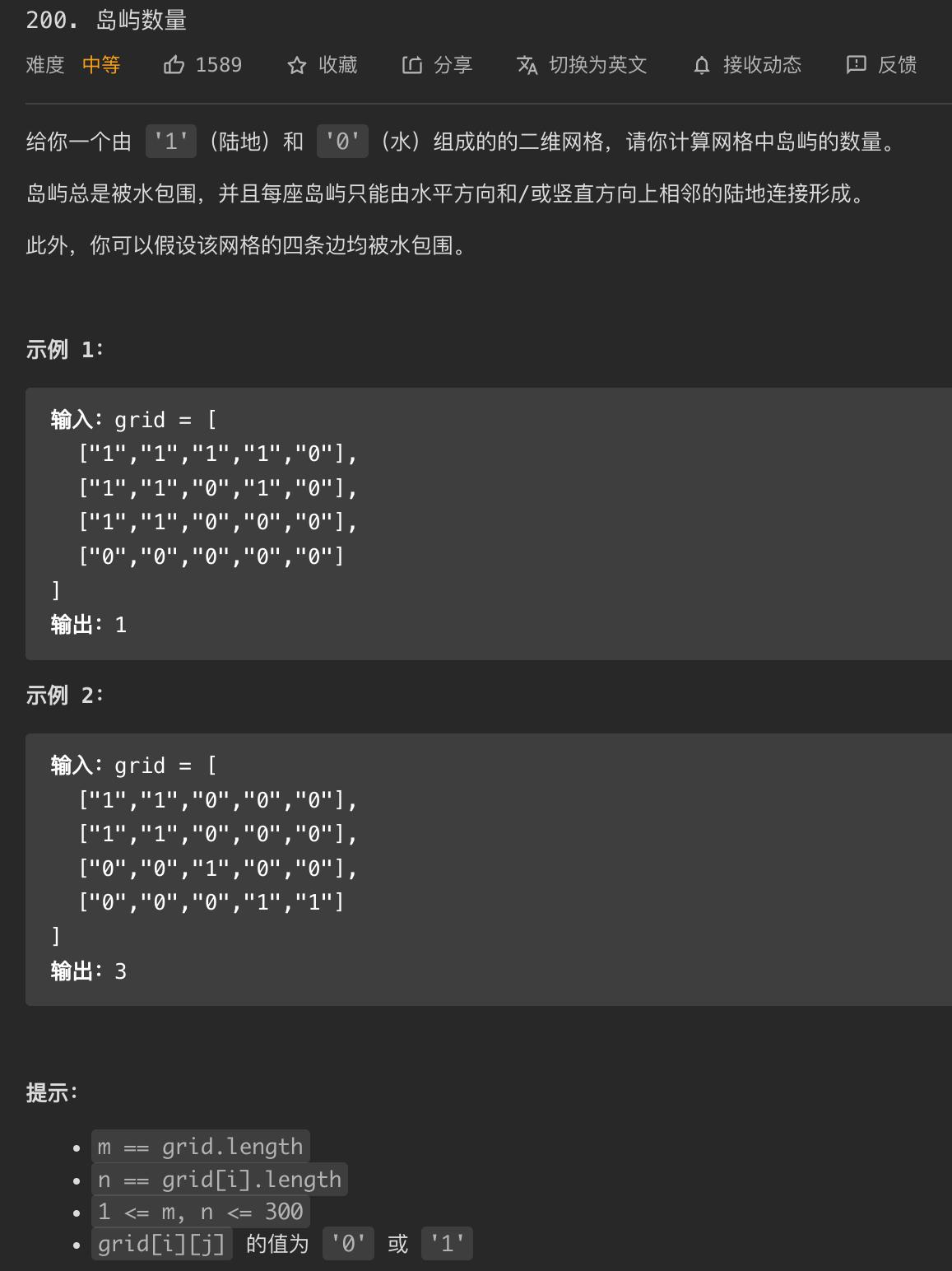
思路1:BFS
- 逐个扫描矩阵,如果发现有1,那么计数器
cnt就 +1 - 然后将这个发现的1的所有相邻的1全部变成0
- 逐个重复这个操作
- 需要注意的是,BFS在将新节点插入的时候就要改变数值,否则会有重复扫描的问题。
代码1:
class Solution {public:int dx[4] = {0, 1, 0, -1};int dy[4] = {1, 0, -1, 0};void bfs(vector<vector<char>>& grid, int x, int y, int row, int col) {queue<pair<int, int>> queue_pos;queue_pos.push({x, y});while (!queue_pos.empty()) {int cur_level_size = queue_pos.size();for (int i = 0; i < cur_level_size; ++i) {pair<int, int> cur_pos = queue_pos.front();queue_pos.pop();int cur_x = cur_pos.first;int cur_y = cur_pos.second;//grid[cur_x][cur_y] = '0';// 考虑将新节点放到树上for (int i = 0; i < 4; i++) {int next_x = cur_x + dx[i];int next_y = cur_y + dy[i];if (next_x < 0 || next_x >= row || next_y < 0 || next_y >= col || grid[next_x][next_y] == '0') {continue;} else {// 此处的0起到标记的作用,防止重复访问grid[next_x][next_y] = '0';queue_pos.push({next_x, next_y});}}}}}int numIslands(vector<vector<char>>& grid) {if (!grid.size()) {return 0;}int cnt = 0;int row = grid.size();int col = grid[0].size();for (int i = 0; i < row; i++) {for (int j = 0; j < col; j++) {if (grid[i][j] == '1') {cnt++;bfs(grid, i, j, row, col);}// cout << grid[i][j] << " ";}// cout << endl;}return cnt;}};
思路2:栈式DFS
- 在弹栈的时候加入序列(也就是变成0)
- 和先序遍历二叉树的思路一样
- 根节点先入栈,然后弹栈,最后将可能的节点都加入栈中
-
代码2:
class Solution {public:void stackDfs(vector<vector<char>>&grid, int x, int y, int row, int col) {int dx[4] = {1, 0, -1, 0};int dy[4] = {0, -1, 0, 1};stack<pair<int, int>> stack_islands;stack_islands.push({x, y});while (!stack_islands.empty()) {// 出栈时加入遍历序列(这里就是变成0了)pair<int, int> cur_pos = stack_islands.top();int cur_x = cur_pos.first, cur_y = cur_pos.second;stack_islands.pop();grid[cur_x][cur_y] = '0';// 入栈for (int i = 0; i < 4; ++i) {int next_x = cur_x + dx[i], next_y = cur_y + dy[i];if (next_x >= 0 && next_x < row && next_y >= 0 && next_y < col && grid[next_x][next_y] == '1') {stack_islands.push({next_x, next_y});}}}}int numIslands(vector<vector<char>>& grid) {int row = grid.size();int col = grid[0].size();int count_islands = 0;for (int i = 0; i < row; ++i) {for (int j = 0; j < col; ++j) {if (grid[i][j] == '1') {count_islands++;stackDfs(grid, i, j, row, col);}}}return count_islands;}};
思路3:并查集
利用
node(i, j) = i * col + j将二维的点变成一维的数字- 遍历
grid当中每一个元素,如果是'1',那么就和它上下左右所有的‘1’放到一个集合当中。 - 遍历
grid当中每一个元素,如果find(node(i,j)) == node(i, j) && grid[i][j] == 1,说明一定是一个新的集合。统计个数即可。 -
代码3:
class Solution {private:int row, col;unordered_map<int, int> fa, r;int dx[4] = {0, 1, 0, -1};int dy[4] = {1, 0, -1, 0};public:bool check_boundary(int x, int y) {if (0 <= x && x <= row - 1 && 0 <= y && y <= col - 1) {return true;} else {return false;}}void init(int n) {for (int i = 0; i <= n; i++) {fa[i] = i;r[i] = 1;}}int find(int x) {if (x == fa[x]) {return x;} else {fa[x] = find(fa[x]);return fa[x];}}void merge(int i, int j) {int x = find(i);int y = find(j);if (x != y) {if (r[x] <= r[y]) {fa[x] = y;} else {fa[y] = x;}if (r[x] == r[y]) {r[y] += 1;}}}int node(int i, int j) {return i * col + j;}int numIslands(vector<vector<char>>& grid) {row = grid.size(), col = grid[0].size();init(row * col + 5);for (int i = 0; i < row; i++) {for (int j = 0; j < col; j++) {if (grid[i][j] == '1') {for (int k = 0; k < 4; k++) {int ni = i + dx[k], nj = j + dy[k];if (check_boundary(ni, nj) && grid[ni][nj] == '1') {merge(node(i, j), node(ni, nj));}}}}}int cnt = 0;for (int i = 0; i < row; i++) {for (int j = 0; j < col; j++) {if (find(node(i, j)) == node(i, j) && grid[i][j] == '1') {cnt += 1;}}}return cnt;}};

